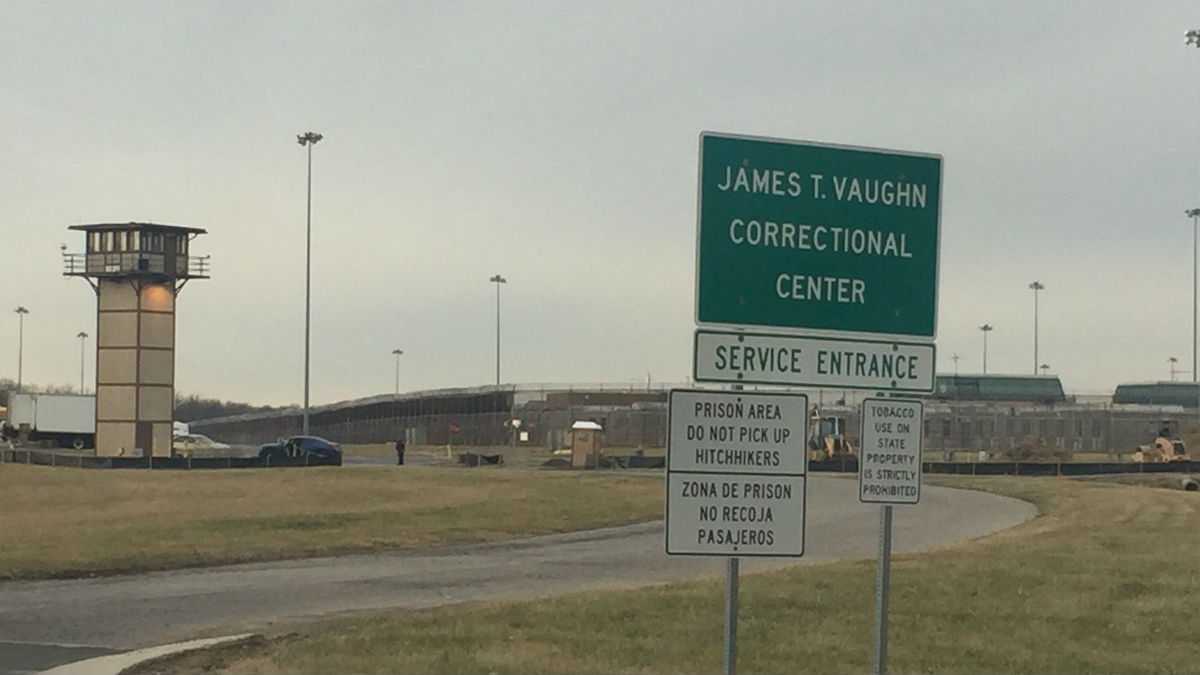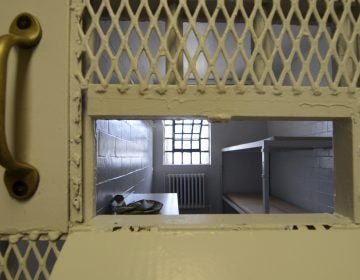As first Del. prison riot trial begins, defendants accuse state of sketchy plea deals

Four people are charged with murder, kidnapping and other crimes in the February 2017 riot at James T. Vaughn Correctional Center. (WHYY)
Men standing trial in connection with the deadly Delaware prison riot in February 2017 contend the court system is stacked against them because fellow inmates are testifying against them to get deals with prosecutors.
Defendants Jarreau Ayers, Deric Forney, Roman Shankaras, Dwayne Staats, and their defense attorneys told a 12-member jury they are innocent as the first of multiple trials related to the standoff began Monday.
“Not that I’m perfect, not that I was perfect that day — I didn’t commit the crime the state claims I committed,” said defendant Ayers, who is representing himself.
“In the process of showing … I didn’t commit those crimes, I’m also going to expose the state. They can’t offer ‘get out of jail’ cards for people’s statements and disregard evidence contrary to that,” he said. “This case is based off the backs of individuals who outright admit they lie to get deals.”
The four are among those charged with murder, assault, kidnapping, riot, and conspiracy in connection with the 18-hour James T. Vaughn Correctional Center prison riot in Smyrna, which led to the death of correctional officer Lt. Steven Floyd.
Floyd’s family chose not to attend the trial.
Ayers and Staats, both representing themselves at trial, already are serving life sentences for murder. Shankaras is serving a seven-year sentence for riot and robbery, and Forney is serving 11 years for various firearm and drug charges.
A year ago, 18 inmates were charged in connection with the standoff, and 16 of them were charged with first-degree murder.
Over the next several months, multiple 12-member juries will be chosen for the trials of four defendants at a time. Each trial is expected to last about four weeks.
On Monday, Shankaras’ attorney Jason Antoine informed the jury of the two inmates who were not charged in connection with Floyd’s death. One of them is Royal “Diamond” Downs, an inmate from Maryland serving a life sentence for first-degree murder.
Antoine predicted Downs will be the state’s “star witness,” despite being the “head honcho inmate” of the prison. Known as the “OG” (Original Gangster) by other inmates, Downs has the power to order hits, Antoine said.
“He was probably the one who ordered the final hit on Floyd. and now he’s working with state,” Antoine said.
During witness testimonies, David Weave, a now-retired sergeant with the Delaware State Police’s homicide unit, said Downs has submitted about four or five testimonies to prosecutors and investigators on the case.
Antoine questioned why Downs had more lenient charges, despite being one of the inmates who allegedly negotiated with officers over the radio during the riot.
The defense attorney also said that during a phone conversation with his significant other, Downs is recorded saying, “There is issues that need to be addressed, and you know what happened to Sgt. Floyd. I’m sorry, you know what I mean. But there is issues that need to be addressed.”
The defendants say there are also several other inmate witnesses testifying on the state’s behalf to get plea deals. They say these witnesses did not see the riot and are unreliable.
“Every time I come across a false accusation, I get agitated,” Staats told the jury. “I’ve been on top of rumors and gossip before, but nothing of this magnitude. Their sole purpose to get on the stand is to capitalize on a person’s death. They want a deal or any form of leniency.”
Antoine argued the inmate witnesses are so unreliable, the jury is “not going to know what to believe at the end of the day.”
‘A vicious planned attack’
However, prosecutor Nichole Warner painted a grim picture of the event.
“The attack was vicious, it was tragically effective, and it was planned,” she told jurors.
There were 134 people in the C Building, a medium- to maximum-security section of the prison — including 126 inmates. The remaining individuals included a few correctional officers and a counselor, as well as members of a fire squad working on a boiler in the basement.
Warner said when Floyd opened the door to the C Building to allow inmates back inside after their recreational period, a group stormed the building, and attacked the officers with mop wringers and homemade knives or “shanks.”
Floyd was handcuffed and placed in a mop closet, while two other officers were placed in a supply closet, she said. The female counselor was approached by an inmate wielding a knife who put a bag over her head and bound her feet while holding her captive in her office, Warner said.
She said when emergency responders entered the building, Floyd told an officer to leave, warning, “It’s a trap.”
The correctional officers trapped inside the supply closet heard Floyd moaning in pain, Warner said. He died from blunt force and stabbing trauma, and was found faced down in his office, covered with debris.
The prosecution team displayed photos of bloodied walls and floors, shanks, debris, and Floyd’s body, and played audio footage of police officers and inmates negotiating over radios.
Warner said Ayers was recorded on the phone prior to the incident saying, “Something big is about to go down,” and that he needed commissary money because he was “going to be on lockdown for a while.” Witnesses also are expected to testify they saw him attacking officers, she said.
Shankaras was the “mastermind” and a “shot caller” during the incident, Warner argued. In a letter, he describes the riot as his vision — and that it occurred exactly the way he imagined. Warner said he “encouraged others to join him,” and “forced them” to commit the riot.
Staats negotiated with police over radio, roaming the prison with a walkie talkie and a shank, Warner said. She said there also are letters in which he wrote about taking responsibility for the riot.
Warner said Forney also assaulted officers.
Antoine argued the incident was supposed to be a peaceful protest of poor prison conditions, and that his client Shankaras didn’t sign up for any violence that day.
“This case is about dignity, it’s about dignity for Mr. Shankaras, the conditions in that prison. It’s about dignity for the rest of the inmates in C Building and how they were treated, and it’s about dignity for Sgt. Floyd and his family,” he said.
“All Shankaras signed up for was a demonstration,” he added. “He didn’t sign up for murder or all this other crazy stuff. Demonstrations are common in failing prisons, and this prison had issues from the top down.”
Antoine said while some of the inmates didn’t like Floyd because he yelled often, his client had a good relationship with the correctional officer. Floyd even got Shankaras a job working in the kitchen, he said.
Antoine also argued his client was in the recreational yard during the time of the riot. He said there’s a camera in the yard that could prove his clients’ innocence, but the system can only survey one location at a time.
“Does that make sense in a prison? We can only control one camera at a time? Don’t you think this would be an important piece of evidence? No one recorded video on the critical event,” Antoine said.
He noted Shankaras wrote the letter about the riot under orders from Downs, arguing it was written as a survival mechanism. He said his client didn’t snitch on any of his fellow inmates because doing so would be a violation of inmate code that could lead to death.
Forney’s attorney Ben Gifford also argued there’s no evidence to prove his client participated in the riot.
“If you are unable to overcome every reasonable doubt, the presumption of innocence demands you vote not guilty. The burden is on the state,” he said.
In December, the state paid $7.5 million to settle a lawsuit filed by six workers in the Department of Correction and five others — including Floyd’s widow and children. The lawsuit was filed against the DOC and former Govs. Jack Markell and Ruth Ann Minner, as well as other prison and budget administrators. They were accused of failing to properly fund and operate the DOC and its facilities.
An independent review of the prison found a dysfunctional, adversarial culture between prison leaders and the rank-and-file, and correctional officers and inmates, both of which, the report states, contributed to the deadly siege.
WHYY is your source for fact-based, in-depth journalism and information. As a nonprofit organization, we rely on financial support from readers like you. Please give today.





